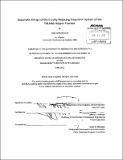Automatic design of the gravity-reducing propulsion system of the TALARIS Hopper Testbed
Author(s)
Cañizales Díaz, Jorge (Jorge Luis)
DownloadFull printable version (14.25Mb)
Other Contributors
Massachusetts Institute of Technology. Dept. of Aeronautics and Astronautics.
Advisor
Jeffrey A. Hoffman.
Terms of use
Metadata
Show full item recordAbstract
This thesis describes a Systems Engineering tool for automatic design, presents the results of its application to the problem of designing Earth-based reduced-gravity simulators, and compares the performance of the found optimal design solutions with that of the MIT TALARIS Hopper Testbed. Earth-based reduced-gravity simulators are platforms that allow hosted vehicles to experience a dynamic environment -from a guidance, navigation, and control perspective- analog to other planetary surfaces. Simulators are used for system development and operator training purposes. Specifically, reduced-gravity simulators produce a constant vertical thrust equal to a fraction of the weight of the studied vehicle, this yielding a perceived gravity equal to the gravity of the celestial body of interest. Planetary hoppers explore planetary surfaces through hopping, i.e. low altitude and short-duration flying. Recently, these systems have gained popularity as cost-effective means for planetary exploration due to their larger operational flexibility compared to other exploration systems. The tool developed as part of this thesis eases the compilation and use of parts catalogs in the design task, includes real-time visualization of the search process, supports the output of multiple solutions that optimize conflicting goals, efficiently calculates Pareto frontiers of solutions, and can integrate external solvers and simulators seamlessly. Chapter 1 overviews the engineering challenges associated with Earth-based reduced-gravity simulators applied to planetary hoppers. Chapter 2 provides the context knowledge required for the development of the individual tasks in this thesis. Chapter 3 discusses the engineering literature covering relevant previous work. Chapter 4 describes the selected approach and the tool that has been developed for the design of the propulsion system of the simulator. Chapter 5 discusses the applicability of the approach and design tool to the case of the MIT TALARIS Hopper Testbed. Chapter 6 summarizes the results and outlines avenues for future research in this field.
Description
Thesis (S.M.)--Massachusetts Institute of Technology, Dept. of Aeronautics and Astronautics, September 2012. Cataloged from PDF version of thesis. Includes bibliographical references (p. 87-93).
Date issued
2012Department
Massachusetts Institute of Technology. Department of Aeronautics and AstronauticsPublisher
Massachusetts Institute of Technology
Keywords
Aeronautics and Astronautics.